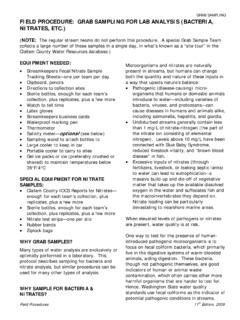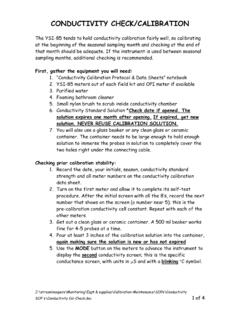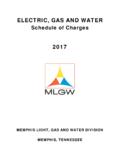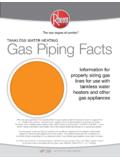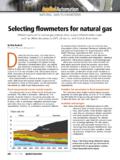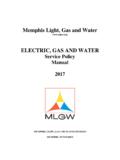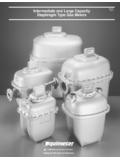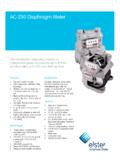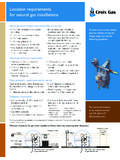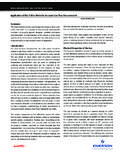Transcription of Understanding Water Meters - Clallam County Home Page
1 Learning to read your Water meter can help you dis-cover Water leaks, monitor your usage and double check your utility bill. All three of these activities may end up saving your household money in the long Meters are typically located in your basement, in a concrete box along the front curb, or along an outside wall to your Meters record Water usage in units of hundreds of cubic feet (Ccf) or gallons. There are two types of Water Meters in use Meter #1 resembles a mileage indicator on an automobile and is read in the same manner. The last two digits to the right can be disregarded as they measure in extremely small units. If zero appears as the last digit to the right, this number never changes.
2 It represents tens of gallons or cubic feet (Ccf) which are recorded by the small pointer determine your Water usage on a monthly basis, write down the meter reading now and then take an-other reading exactly one month from now. Subtract the old reading from the new reading and you will have the number of Water units your household consumed within one month. You can also check your Water usage for one day by taking a read-ing now and then again tomorrow (this time, include the last two digits as the usage number will be much smaller for one day). Subtract the first reading from the second and you will have the amount of Water used in one Meter #2 looks like a series of small clocks that alternate turning clockwise and counterclockwise.
3 The dials can be read by starting with the highest numbered dial (usually 100,000 or 1,000,000) and ending with the dial marked 1,000. The shaded dials labeled 100, 10 and one foot can be disregarded for now because they measure small amounts of at the pointer on the highest numbered dial. If it is between two numbers, write down the lower num-ber. In the example above, this would be 4 on the dial labeled 1,000,000. If the pointer seems to be on a number, check the pointer on the next lower dial. If that hand is located on the 1 side of the zero, read the figure indicated. If not, read the lower the number may seem tricky when the pointer is between the zero and the nine. In that case, the zero is actually a ten, so nine would be the lower number to choose.
4 If the pointer is in between the zero and the one, the chosen number would be zero be-cause zero is less than meter dial would read 9 because nine is less than 10 (zero represents 10 in this case because of the location of the arrow between the nine and the 10.) Likewise, this meter dial would read 0 because zero is less than one. Understanding Water Meters (continued on other side)0587649312 As with the first meter, take a reading now and again in one month. Subtract the old reading from the new one and you will have your Water usage for the month. To do a daily meter reading, write down all of the numbers except for the number from the one foot dial. In this case, remember that your reading will be in hundred cubic feet (ccf) instead of cubic leaksNow that you know how to read your meter, use this knowledge to locate money-wasting leaks in your home.
5 First, turn off all Water inside and outside your home. Then, read your meter. Mark where the pointer hand or one foot hand is on your meter (depending on which kind of meter you have). Wait 15 to 20 minutes and then look at the hand again. If the hand has moved, you have a leak in your metersSome residential consumers may be able to add a deduct meter that, depending on how they use Water , may reduce the sewage portion of their bills. While in Ohio, investor-owned Water companies do not currently allow their customers to use deduct Meters , customers served by municipalities or other Water companies should ask if a deduct meter is an purchased from the Water company and installed, a deduct meter will specifically measure the amount of Water not flowing into the sewer system.
6 For those consumers who use large amounts of Water for landscaping, filling swimming pools, washing cars or other outdoor activities, this type of meter would help reduce sewage charges. A consumers existing Water meter would continue to measure total usage to determine the Water portion of their bills. While a deduct meter may help to save money, the upfront cost of the equipment and installation can cost several hundred dollars. Depending on the Water company s policy, installation which typically hooks the additional meter up to outside Water faucets may be required to be performed by one of their employees. If installation can be performed by a consumer s plumber, an inspection of the deduct meter by the Water company must follow.
7 There also may be a separate monthly charge for using a deduct meter. Customers should ask their Water company if a monthly charge household appliances To find out how much Water (and money) is required to run your dishwasher, shower or washing machine, do the following: First, turn off all Water in the house. Take a Water meter reading. Then, turn on the appliance you wish to monitor. When the appliance has shut off, take another reading. Subtract the old from the new reading to discover how much Water was used. Multiply this usage by the volumetric rate obtained from your most current Water bill or from your Water company to determine the cost to run the Ccf into gallons 748 gallons = 1 Ccf Multiply the number of Ccf by 748 gallons to get the number of gallons used.
8 Sample: 12 ccf x 748 gallons = 8,976 gallons0587649312 2006 Office of theOhio Consumers Counsel May be reprinted with permission. H2O (continued from other side)For additional information from the Office of the Ohio Consumers Counsel:Call: 1-877-PICKOCC (1-877-742-5622) toll free or (614) 466-8574 Write: 10 West Broad Street, Suite 1800, Columbus, Ohio 43215-3485E-mail: Internet Address: Office of the Ohio Consumers' Counsel (OCC), the residential utility consumer advocate, represents the interests of mil-lion households in proceedings before state and federal regulators and in the courts. The state agency also educates consumers about electric, natural gas, telephone and Water issues and resolves complaints from individuals.
9 To receive utility information, brochures, schedule a presentation or file a utility complaint, residential consumers may call 1-877-PICKOCC (1-877-742-5622) toll free in Ohio or visit the OCC website at Office of the Ohio Consumers Counsel is an equal opportunity employer and provider of services.

